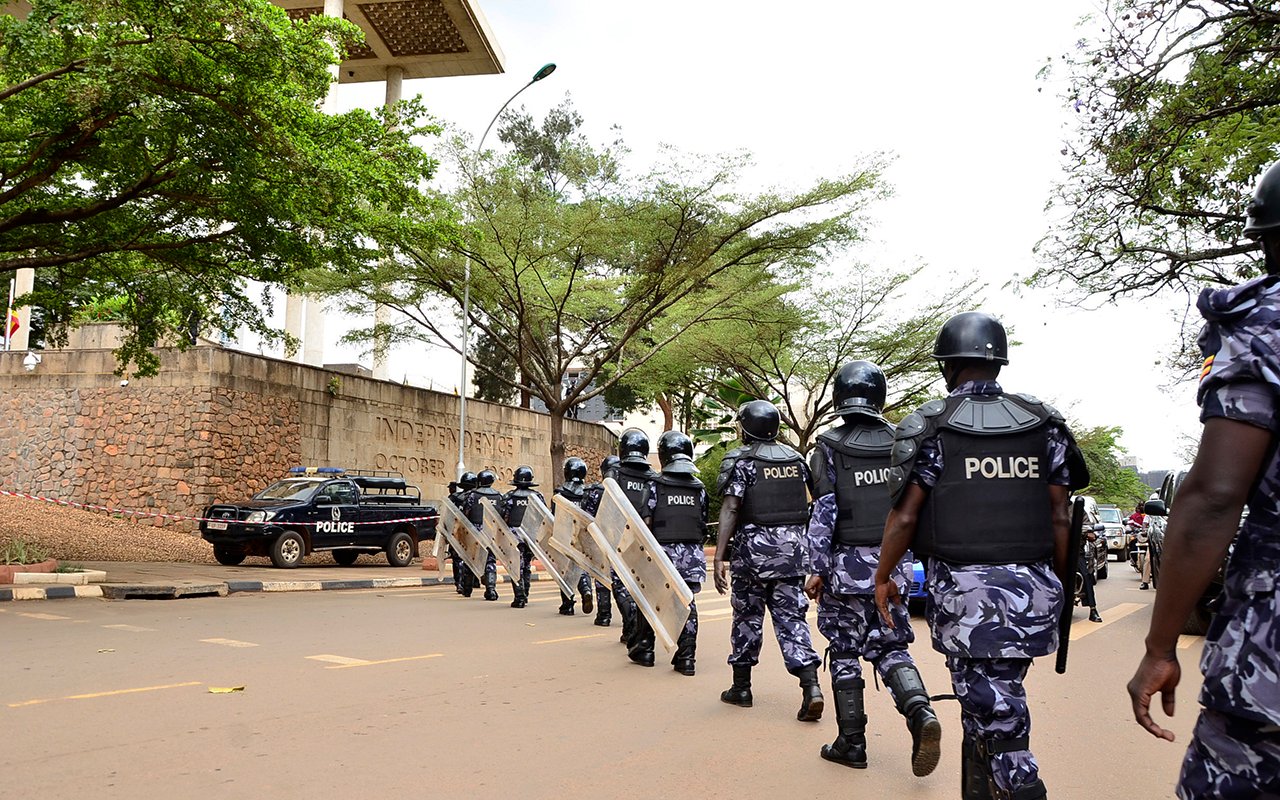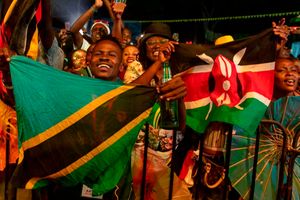
Anti-riot police cordon off Parliament during the age limit debate in 2017. A group of youth want to march to Parliament on Tuesday. PHOTO/ FILE
The fortresses built to protect the interests of the Kenyan ruling elite that previously appeared impregnable came tumbling down after the bread protests led by youngsters compelled President William Ruto to fire his entire Cabinet, about a week ago.
“I will immediately engage in extensive consultations across different sectors and political formations and other Kenyans, both in public and private, with the aim of setting up a broad-based government,” Ruto announced after about 50 youngsters were killed in the violent protests.
Could the howling gales in the neighbouring country barrel eastwards towards Uganda?

The mess after Kenyan protestors briefly occupied parliament recently.
On Tuesday, July 23, the angst against corruption is expected to reach a crescendo when youngsters march to Parliament to protest against corruption, which is a blot on the national conscience. It comes at the peak of an embarrassing spectacle where the governments of the United Kingdom and the United States sanctioned the Speaker of Parliament Anita Among and the desecrated House turning into a symbol for the nouveau riche and corrupt.
President Museveni has recently preached fire and brimstone against corruption at Parliament and appealed to investigating agencies to expedite the trial of prominent politicians, including former ministers, MPs, and Permanent Secretaries implicated in corruption scandals.
Two former ministers Mary Goretti Kitutu and Agness Nandutu alongside junior Finance minister Amos Lugoloobi are currently facing trial in the Anti-Corruption Court, and several lawmakers are presently being held at Luzira Prisons for various corruption-related charges.
The State on Friday charged the Trade Ministry Permanent Secretary, Ms Geraldine Ssali Busuulwa, with several corruption-related offences, including conspiring with Members of Parliament to steal billions of shillings meant to compensate cooperatives in a dubious scheme facilitated by lawyers.
Whereas the President’s tough stance has placated public sentiments, youngsters are demanding the Speaker resign or be forced out through protests.
But the director of communications at Parliament, Mr Chris Obore, who pilloried the protestors as self-righteous activists in an opinion he authored in Monitor newspaper recently claimed that, “The regime change protagonists, having exhausted all strategies to bring down government and failed, have now impressed upon their funders a new idea; demonise and mobilise common anger against Parliament mostly on unverified, unfounded presumptions and castigate it before the eyes of the public as an accountability smokescreen, yet the actual intention is to use that anger to catalyse a violent, anarchical change of government.”
His commentary contrasts the views of some NRM lawmakers including Lwemiyaga County MP Theodore Ssekikubo, who says the march to Parliament enjoys the tacit approval of the President and the Speaker must carry her cross.

Speaker of Parliament Anita Among. Photo/File
By Friday, there was a growing chorus of government officials, including the Uganda Media Centre executive director, Mr Ofwono Opondo, calling upon the police to allow the protestors to peacefully march.
“Hogwash! Revisionist thinking. People took up arms, went into the wilderness and returned victorious. Today Ugandans are seeing some light at the end of the tunnel. Viva@Kaguta Museveni. Alluta Continua,” Opondo wrote on the microblogging site, X, in a rebuke to those who are imploring young protesters to abandon the march to Parliament.
Earlier on Friday, the police director for operations, Mr Frank Mwesigwa, issued a statement claiming that, “Uganda Police Force has credible intelligence that some elements want to use this opportunity to disrupt public order and incite violence. In light of this, the UPDF is mandated to protect the citizens of Uganda against threats of anarchy and disorder. Uganda Police shall not allow ant form of demonstrations in crowded cities and towns to disrupt lawful activities.”
But the Tororo Woman MP and former junior Energy minister, Sarah Opendi, responded on X. “The President recently called on citizens to join in the fight against corruption. If people prefer to express their opinions through peaceful demonstrations, I expect security to issue guidelines and provide security but not threats. The fight against corruption should be supported.”

Kenyan police arrest a protestor in the capital Nairobi.
The Kenya bread protests share parallels with Uganda’s march to Parliament; a growing groundswell of resentment against a corrupt political elite that has excluded youngsters from politics and stolen taxpayers’ money to feather their nests; a soaring cost of living and high levels of unemployment in a society that has pushed merit on the back burner.
The extremes are so disproportionate that the median age of Uganda, which has the second youngest population in the world after Niger is 16 starkly contrasting the median age of Uganda’s Cabinet, which is at 61.

Military Police patrol the streets of Kampala during the presidential age limit debate in 2017. Photo/ ABUBAKER LUBOWA
The youngsters have found a willing ally in government, Internal Affairs minister, Maj Gen Kahinda Otafiire, whose message has replenished the wellspring of revolutionary lore and stoked the flames. “Now young people, I want to challenge you that you should support those of us who stand up and say no. The struggle for freedom, the struggle for justice should not be in vain,” Otafiire clutched his pearls in exasperation a week ago.
“We went to fight, not to enrich people, but to correct the situation in the country. People died [during the Luweero Bush War]. We didn’t die for the glorification of the corrupt. Down the road, we seem to have digressed to the extent that you people love the corrupt. You glorify inequity. Stand up and tell us sorry enough is enough.”
An acolyte of President Museveni who is amongst those who formed the third phase of social movement resistance in Africa as guerrilla fighters against a sitting government linked to national movements that emerged on the eve of independence, Otafiire was part of the Front for National Salvation (Fronasa) a Marxist movement led by Museveni to fight the Idi Amin dictatorship in the 1970s.
Museveni graduated at Dar es Salaam University in 1970, the melting pot of radical Marxist thought led by Guyana scholar, Walter Rodney and Black Panther’s Stokely Carmichael, the leader of the African-American liberation movement in the US. Museveni preached the radical message of the Algerian revolutionary of Frantz Fanon whose treatise, ‘The Wretched of the Earth’ advocated for violent uprisings against imperialists—to his young converts including Otafiire who picked arms and waged a guerrilla rebellion during the Luweero Bush War between 1981 and 1986.
Perhaps by agitating that the Luweero struggle should not be in vain, Otafiire’s speech serves as a symbolic moment for the old guard which during the Bush War preached the values of a spartan lifestyle and despised corruption— to pass the revolutionary baton to the young Turks.
Led by the fourth phase of resistance, these youth-led protests could offer new insights into the kaleidoscope of African social movements, which include trade unions, burial societies, students, and religious groups. The Kenyan bread protestors relied on the hybrid model—infusing tactics from the West and oral traditional methods from nativist primary social movements like Bunyoro’s Omukama Kabalega to frame the political elite as the new masters who have taken the place of colonialists.
Uganda’s march, which has placed leaders including the Speaker in the crosshairs, has tried to mimic the Kenyan bread protests in various ways of mobilisation. It is faceless and has been organised on social media platforms, which are ubiquitous, difficult to infiltrate, and distinctly different from the opposition-led protests, which are easy to infiltrate by the state.
On Friday, the microblogging site X hosted a combustible debate, which largely focused on the legality of the protests.
Article 43 of the Constitution, provides for permissible restrictions in the enjoyment of the rights and freedoms and makes the right to demonstrate not absolute. It thus reads in Article 43 (1) that in the enjoyment of the rights and freedoms prescribed in this chapter, no person shall prejudice the fundamental or other human rights and freedoms of others or the public interest. However, Article 43 (2) provides that public interest under this article shall not permit political persecution and detention without trial; and Article 43 (2 (c) further provides that no person shall prejudice the fundamental or other human rights and freedoms of others or the public interest beyond what is acceptable and demonstrably justifiable in a free and democratic society.
However, Supreme Court Justice Joseph Mulenga, who wrote the lead judgment in the landmark case of Charles Onyango-Obbo and Andrew Mwenda versus the Attorney General in 2004, posited that “It is apparent from the wording of clause (2) that the framers of the Constitution were concerned about a probable danger of misuse or abuse of the provision in clause (1) under the guise of defence of public interest. For avoidance of that danger, they enacted clause (2), which expressly prohibits the use of political persecution and detention without trial, as means of preventing, or measures to remove, prejudice to the public interest.”
He added: “In addition, they provided in that clause a yardstick, by which to gauge any limitation imposed on the rights in defence of public interest. The yardstick is that the limitation must be acceptable and demonstrably justifiable in a free and democratic society. This is what I have referred to as a limitation upon the limitation”.
In view of the proponents of the peaceful march to Parliament, the impugned claim that the protests risk the danger of unleashing violence falls within the category of what Mulenga termed as the probable misuse of the law to halt a peaceful procession, which is demonstrably justified in a free and democratic society, under the guise of protecting the public interest. Like the spider sitting at the centre of the cobweb of influence, the army, which is the coercive arm of the State, has often been assigned the role of scuttling protests. How can the organisers of the protest ensure that criminals and fifth columnists do not infiltrate the protests and cause chaos, which may lead to the justification of the deployment of the army?
Timothy Kalyegira, a journalist and researcher told Sunday Monitor, “The first thing for Uganda’s youth to bear in mind is that the NRM government is different from Kenya’s which is more like Zambia’s or Malawi’s. Museveni’s is like Rwanda’s Ethiopia’s, and Eritrea’s. Armed guerrilla movements that became governments but which, retain a military-first mindset. They are more likely to use excessive force of intelligence tactics.”

A Kenyan protestors on the streets of Nairobi.
He says, “While Kenya’s protests started spontaneously, Uganda’s have specified a date and a venue, giving the State time to prepare well in advance. So Uganda’s will be met by a heavy security presence and, having learned from Kenya, the possibility that social media could be switched off.”
Whereas Uganda pales in comparison to the Stalinist-Eritrean regime led by Isaias Afwerki, Kalyegira warns that, “Museveni is the type to take measures that no Kenyan head of state, not even Daniel arap Moi, can ever take against the population. The army can raid the High Court in broad daylight and re-arrest bailed suspects, something inconceivable in Kenya. I don’t know if the planners of Uganda’s protest have thought through all these scenarios. Their chances of success will depend on if they have.”
Rest of the World, a publication that files stories on global tech, recently reported that thousands of Kenyans used Zello, which mimics a walkie-talkie, to coordinate movements and communicate anonymously during the bread protests.
Zello confirmed that the app, developed by US engineer Alexey Gavrilov in 2007, became the primary tool for protestors to communicate, mobilize crowds, and coordinate logistics and was downloaded 40,000 times on the Google Play store in Kenya during the week of the protests.
Six protesters told Rest of the World that Zello, which allows smartphones to be used as walkie-talkies, helped them find meeting points, evade the police, and alert each other to potential dangers.
Tech tools such as Zello are versatile in mobilising youngsters to march to Parliament peacefully. Beyond mobilising legions, such tools must also be used to robustly report any incidents of violence and expose any fifth-columnists whose intention is to tarnish the reputation of the protests.








